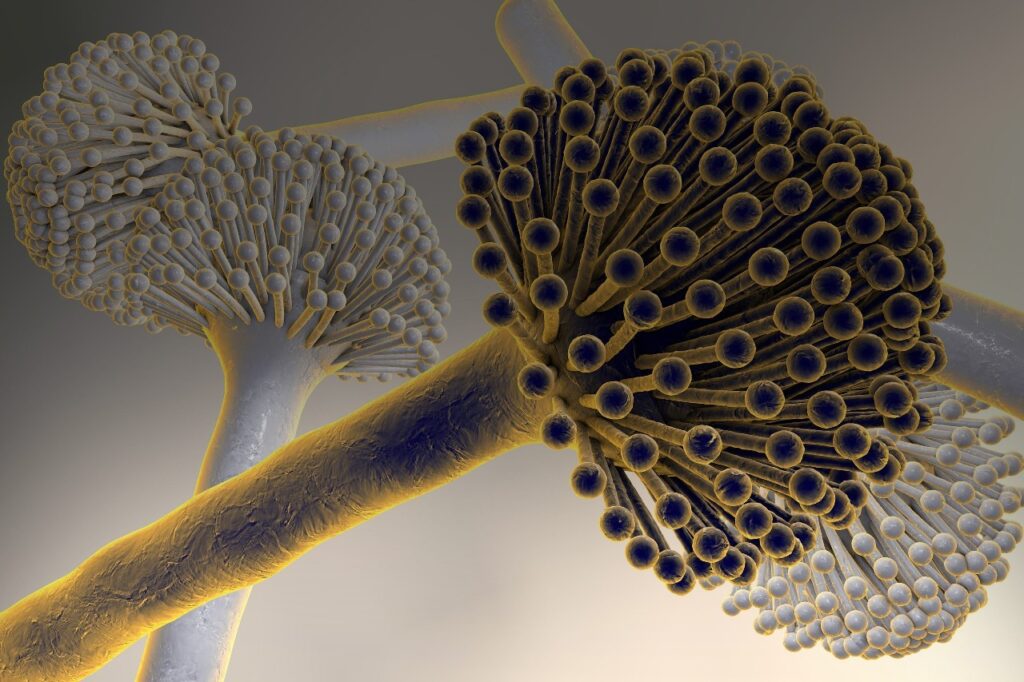Aspergillus niger is a filamentous fungus found throughout nature, notably in soil and decomposing organic waste. It belongs to the Aspergillus genus and is distinguished by its black conidial heads. Aspergillus niger is well-known for its industrial and biotechnological uses, but it is also a prevalent food and indoor contamination source. This overview delves into its taxonomy, morphology, physiology, industrial uses, and pathogens.
Table of Contents

Characteristics of Aspergillus Niger
- A. niger produces black or extremely dark brown colonies with smooth, long conidiophores terminating in round vesicles and spherical conidia in chains.
- It is abundant in soil, plant detritus, indoor air, and decaying organic materials, and thrives in a variety of environments.
- A. niger is used in biotechnology to make enzymes and citric acid for food processing, detergents, and other uses.
- Although it is normally harmless to healthy people, it can cause opportunistic infections such as aspergillosis in immunocompromised persons.
- A. niger may create mycotoxins such as ochratoxin A, which can endanger human health by contaminating food and feed items.
Physiology and growth conditions
Aspergillus niger is a mesophilic organism that thrives at temperatures ranging from 15°C to 40°C, with an optimum growth temperature of 37°C. It can grow in a wide pH range, often between 1.5 and 9.8, demonstrating its resilience to many environmental circumstances. This fungus can use a wide range of carbon sources, including simple sugars, organic acids, and complex carbohydrates, which adds to its ubiquity and adaptability.
Taxonomy of Aspergillus Niger
| Kingdom | Fungi | Order | Eurotiales |
| Phylum | Ascomycota | Family | Trichocomaceae |
| Class | Euascomycetes (Eurotiomycetes) | Genus | Aspergillus (section Nigri) |
Aspergillus niger belongs to the Fungi kingdom, the Ascomycota phylum, the Eurotiomycetes class, the Eurotiales order, the Aspergillaceae family, and the Aspergillus genera. The species’ name “niger” relates to the black hue of its spores.
Morphology of Aspergillus Niger
Morphologically, A. niger has septate hyphae and conidiophores that end in globose vesicles. These vesicles contain sterigmata, which produce chains of conidia (asexual spores). The conidia are generally spherical, black, and rough-walled, lending the fungus its distinct look. A. niger colonies spread quickly across a variety of media, creating a characteristic black or extremely dark brown appearance.
Habitat of Aspergillus Niger
Soil: Found in soil rich in organic materials.
Decaying Plant Material: Found on rotting leaves and fruit.
Compost and Manure: Present in compost piles and manure
Indoor Environments: Grows in wet places like basements and bathrooms, as well as on moist construction materials.
Stored Food: Stored food can contaminate grains, seeds, nuts, fruits, and vegetables.
Industrial Settings: Industrial applications include the synthesis of enzymes and citric acid through fermentation processes.
Life cycle of Aspergillus Niger
– Spore formation: Tiny reproductive structures called spores are produced.
– Spore dispersal: Spores are discharged into the environment.
– Germination: When conditions are right, the spores germinate.
– Hyphae formation: Germinated spores create thread-like structures known as hyphae.
– Mycelium growth: As the hyphae expand and branch out, they create a network known as mycelium.
– Asexual reproduction: The mycelium generates asexual spores called conidia.
– Conidia release: The conidia are dispersed into the environment.
– Sexual reproduction (optional): Under certain conditions, Aspergillus Niger may reproduce sexually and produce sexual spores known as ascospores.
Industrial Applications
A. niger is well-known for its widespread application in biotechnology and industrial processes due to its capacity to produce significant amounts of enzymes and organic acids. Some of its main industrial uses are:
Enzyme Production
Amylases are used in the starch processing and textile industries.
Proteases are used in the detergent, food, and pharmaceutical sectors.
Pectinases are used in the fruit juice business to clear juices and wines.
Cellulases and hemicellulases are important in biofuel generation and the paper industry.
Glucose oxidase is used in the food business for glucose elimination and in biosensors.
Organic Acid Production
Citric Acid: A. niger is the main industrial producer of citric acid, which is used as a preservative, acidulant, and flavoring ingredient in food and drinks. Citric acid generation by Aspergillus niger includes the fermentation of carbohydrates such as sucrose or glucose.
Gluconic Acid is used in the food and pharmaceutical sectors due to its chelating characteristics.
Biotransformation
A. niger is employed in the biotransformation of different chemicals, including steroids, for therapeutic purposes.
Pathogenicity and Health Implications
While A. niger is typically considered harmless to healthy people, it can be an opportunistic pathogen, especially in immunocompromised patients. It is one among the substances responsible for aspergillosis, a spectrum of disorders that range from allergic responses to severe systemic infections. The most prevalent conditions induced by Aspergillus niger are:
Allergic Aspergillosis (ABPA) is a condition that predominantly affects people who have asthma or cystic fibrosis.
Aspergilloma, sometimes known as a “fungus ball,” is a disorder in which Aspergillus niger colonizes pre-existing lung cavities, frequently resulting in persistent cough and hemoptysis.
Invasive Aspergillosis is a serious illness that can attack several organs and is typically deadly if not treated quickly, affecting predominantly immunocompromised people.
Control and Management
Controlling A. niger infection in industrial and clinical settings requires strict hygiene measures, continuous monitoring, and the use of antifungal medications as needed. In industrial operations, regulating fermentation conditions can reduce contamination risks while increasing production efficiency. Antifungal medicines including itraconazole, voriconazole, and amphotericin B are routinely used for clinical infections, although resistance is a growing concern.
To conclude, Aspergillus niger is a versatile and productive fungus that has several uses in biology and industry. Despite its many benefits, it also poses health hazards, particularly to disadvantaged groups. Continued study into its biology, pathogenicity, and industrial potential is critical for maximizing its usage and successfully minimizing its hazards.
Frequently Asked Questions (FAQ)
What in particular is Aspergillus niger used for?
Aspergillus niger is used to generate extracellular (food) enzymes and citric acid.
Is Aspergillus niger dangerous to people?
Aspergillus niger may accumulate in human tissue and cause a number of significant health problems.
What acid is generated by Aspergillus niger?
Citric Acid is generated by Aspergillus niger
Related articles

